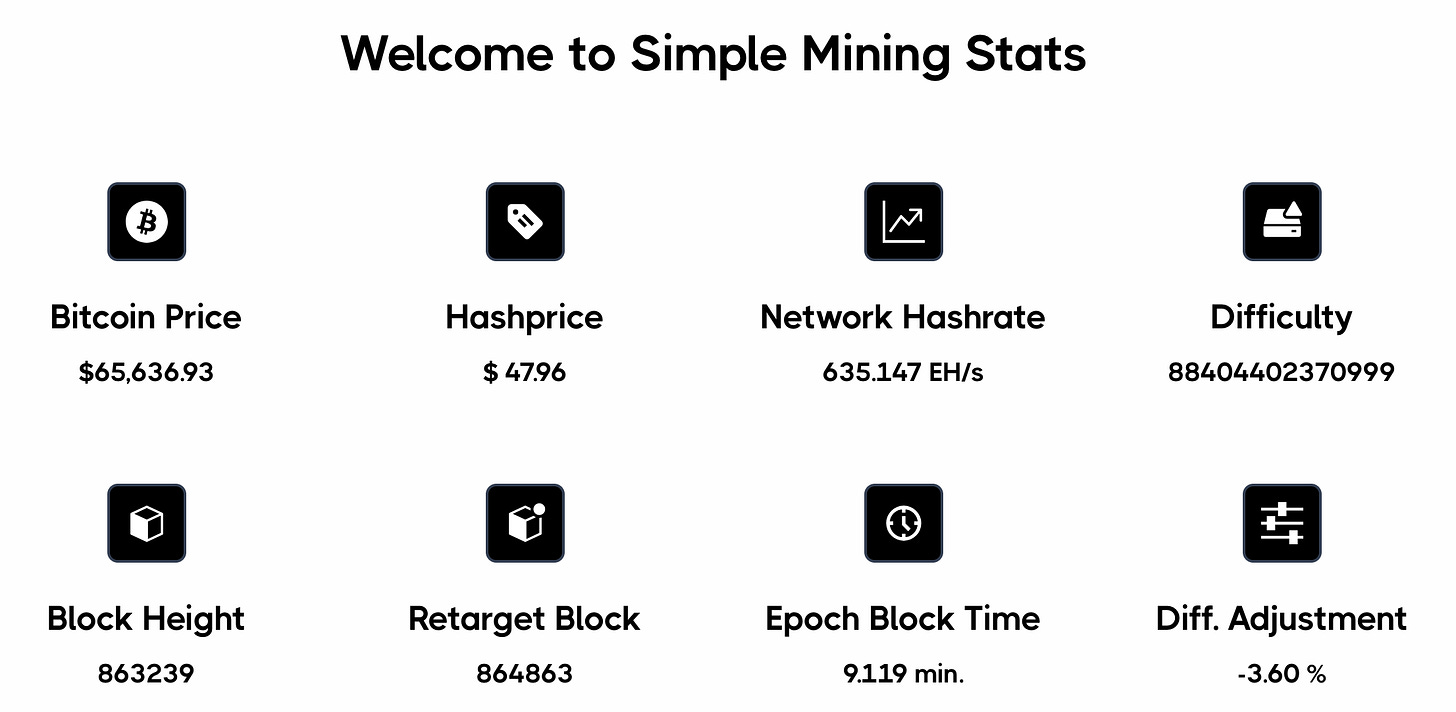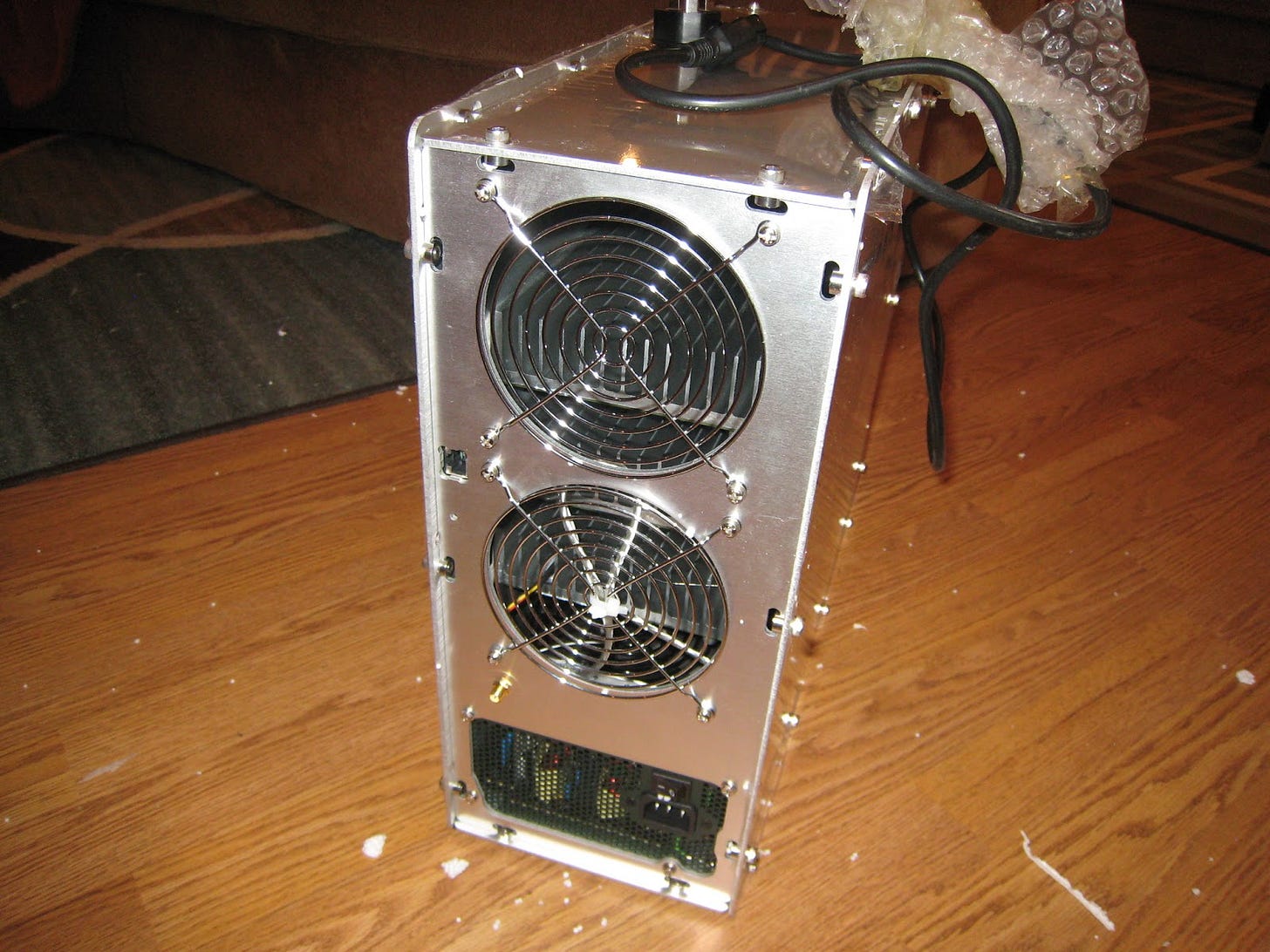Was Satoshi a Socialist?
A history of Bitcoin mining rigs
Happy Saturday miners,
The market has responded optimistically to the dovish monetary policy last week.
Bitcoin is ~ 11% away from its all-time high six months ago.
Difficulty dropped - 4.6% this week.
Hashprice has vacated the gutter.
This also may be sentiment anticipating “uptober.”
October is historically a green month for Bitcoin, with the last four years averaging +22%:
Another interesting observation is every time September has closed in the green, October, November, and December also close in the green.
Bitcoin mining through the years
As mentioned in Miners vs Nodes, Bitcoin was originally mined using CPU power from a personal computer.
The CPU is the central processing unit of a computer and is responsible for completing various tasks.
From 2009-2010, CPU mining was feasible because the network's difficulty was low, and the competition was minimal.
A CPU can process a few operations at a time, and in the early days, this was adequate technology for computing hashes and earning block rewards.
This was until Laszlo Hanyecz (the guy who bought two pizzas for 10,000 BTC) started experimenting with GPU mining.
Here is a post from Laszlo in 2010 discussing this:
GPU mining presented faster calculations than CPU mining (3800k > 1800k).
Satoshi was not initially a huge fan of this.
Satoshi emailed Laszlo about it:
A big attraction to new users is that anyone with a computer can generate some free coins.
When there are 5000 users, that incentive may fade, but for now it’s still true.
GPUs would prematurely limit the incentive to only those with high end GPU hardware.
It’s inevitable that GPU compute clusters will eventually hog all the generated coins, but I don’t want to hasten that day.
I don’t mean to sound like a socialist, I don’t care if wealth is concentrated, but for now, we get more growth by giving that money to 100% of the people than giving it to 20%.Satoshi was vigilant in making sure Bitcoin scaled appropriately.
He did not want the supply to become centralized by GPU miners.
Laszlo commented on this years later:
“That’s when I was like, ‘Man, I feel like I crapped up your project. Sorry, dude.' He was concerned that some people might be discouraged because they can’t mine a block with a CPU. So, I stopped advertising it after that.”
Satoshi was right because GPUs ended up hogging the network hashrate.
Bitcoin’s difficulty only adjusted downward three times for the first 32 months of its existence, and GPU mining was a major contributor.
GPU miners pushed CPU miners out of profitability and started building "rigs" with multiple GPUs to maximize their hash rate.
Fun fact: Simple Mining started mining with GPU rigs.
This period saw the beginning of industrial-scale mining setups, with large rooms full of GPU rigs.
The dawn of the professional Bitcoin mining industry.
In June 2011, FPGAs (field-programmable gate arrays) came into the picture.
FPGAs are specialized hardware that can be configured to perform specific tasks, including mining Bitcoin.
They were more efficient than GPUs, consuming less electricity for the same amount of computational power.
This was all leading up to the introduction of the ASIC in 2012.
ASIC devices operate ~ 100 billion times faster than the average CPU in 2009.
As you can see, ASICs significantly increased the efficiency and hash rate of miners (the difficulty scale is logarithmic).
ASICs (application-specific integrated circuits) are designed specifically for Bitcoin mining.
They do one thing and one thing only: solve the SHA-256 hash algorithm used in Bitcoin's proof-of-work.
Unlike previous adaptations, this innovation focused on creating dedicated machines to be used solely for Bitcoin mining.
The first ASIC was the Avalon V1 by Canaan Creative.
This machine offered 68 GH/s (gigahashes per second), efficiency of 9500 J/GH, and was priced around $1,500.
Bitmain later launched the Antiminer S1, offering 180 GH/s, 2000 J/TH, and 360W.
Bitmain has since dominated the Bitcoin mining hardware industry, consistently releasing more advanced technology:
One notable development since 2013 has been the consistent reduction in chip size, from an initial 130nm down to 7nm in the latest models.
Chip size directly impacts mining efficiency.
Larger ASIC chips require more electricity for data transmission due to wider communication channels.
ASICs have been the standard for over a decade.
Without a radical new ground-breaking upgrade, hardware and equipment will not be the primary competitive advantage for bitcoin miners.
The upgrades boasted by each new model are diminishing.
It is currently physically impossible to improve past 0 jules per terahash (use 0 electricity per hash).
The future competitive advantage for miners could fall under innovations in energy sourcing, financial planning, or product diversification.
One outcome is likely:
Mining difficulty will go up for the foreseeable future. Cheap and sustainable electricity is the name of the game.
Bitcoin mining has exploded as an industry and will continue to evolve and advance to re-invent how proof-of-work calculations secure the network.
This is one of the brilliant principles of Bitcoin:
It is a cyber monetary technology that can upgrade itself and will not be deemed obsolete by a market disruption.
This is why gold failed.
Have a good weekend✌️











A visão política de Satoshi Nakamoto, o criador do Bitcoin, é mais alinhada com o libertarianismo do que com o socialismo ou comunismo.
Embora o artigo mencione que Satoshi estava preocupado com a centralização da riqueza e queria garantir que o suprimento de Bitcoin não fosse concentrado nas mãos de poucos indivíduos, isso não significa que ele era socialista ou comunista.
Na verdade, o design do Bitcoin e sua filosofia subjacente são mais consistentes com os princípios libertários, que defendem a liberdade individual, a propriedade privada e a minimização do controle governamental.
Satoshi Nakamoto criou o Bitcoin como uma forma de dinheiro descentralizado, que não depende de governos ou instituições financeiras centrais. Isso é mais alinhado com a visão libertária de que os indivíduos devem ter controle sobre suas próprias vidas e recursos, sem a interferência do Estado.
Além disso, o Bitcoin é baseado em uma economia de mercado livre, onde os indivíduos são livres para comprar, vender e negociar sem restrições governamentais. Isso é mais consistente com a filosofia libertária do que com a socialista.